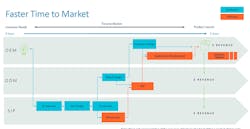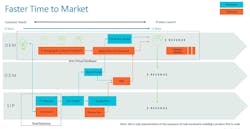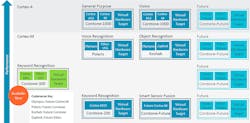Reduce Software Development Time Using Cloud-Based Virtual Platforms
What you’ll learn:
- What is Arm Corstone?
- What is Project Centauri?
- How Arm’s Total Solutions for IoT will reduce the software development cycle.
Delivering an embedded solution means designing and implementing the hardware and the software that runs on it. The conventional software development cycle starts when hardware becomes available (Fig. 1). The entire process can take years when starting from silicon. Virtual hardware may shorten this process, but often the virtual support is specific to the platform, which also takes time to develop.
Of course, many embedded hardware solutions these days are based on Arm Cortex platforms, especially IoT solutions utilizing the Arm Cortex-M family of microcontrollers. And virtual hardware support is readily available from a number of sources.
Arm is looking to add to the mix with its Arm Total Solutions platform, which is built around standardized virtual models containing common configurations that are the foundation for IoT solutions. The ability to select from this collection allows developers to significantly reduce the overall development cycle (Fig. 2).
The Total Solutions platform is based around a few key Arm partnerships and IP, including virtual hardware that’s available as an Amazon Machine Image via Amazon AWS and the AWS marketplace. The images are currently available for free, but running them on AWS will cost money.
The other piece to the puzzle is Arm Corstone. These are fixed virtual prototyping (FVP) solutions based on Arm cores. They’re matched with third-party software like RTOSes that include RTX, FreeRTOS, Zephyr, and Mbed OS. Corstone currently supports subsystems such as Cortex-M3, Cortex-M23, Cortex-M33, Cortex-M55, Cortex-A5, and Cortex-A32 with Cortex-M support (SSE-700). All are available via ArmFlexible Access license.
Finally, there’s an ecosystem that Arm calls Project Centauri. It targets Cortex-M platforms whereas the earlier Project Cassini homed in on Cortex-A class platforms. The Arm Total Solution SDK aligns with Project Centauri and supports PSA Certified and Open-CMSIS-CDI solutions. Open-CMSIS-CDI is a cloud-to-device specification designed to minimize the effort required to support different RTOSes and cloud connectivity solutions.
Solutions created with the Total Solutions platform address typical configurations like keyword recognition used by voice-activated systems such as Amazon Alexa or vision applications (Fig. 3). Corstone platforms are pre-designed, pre-verified, and pre-validated subsystems that eliminate much of a hardware designer’s workload while providing virtual hardware support for software developers.
About the Author
William G. Wong
Senior Content Director - Electronic Design and Microwaves & RF
I am Editor of Electronic Design focusing on embedded, software, and systems. As Senior Content Director, I also manage Microwaves & RF and I work with a great team of editors to provide engineers, programmers, developers and technical managers with interesting and useful articles and videos on a regular basis. Check out our free newsletters to see the latest content.
You can send press releases for new products for possible coverage on the website. I am also interested in receiving contributed articles for publishing on our website. Use our template and send to me along with a signed release form.
Check out my blog, AltEmbedded on Electronic Design, as well as his latest articles on this site that are listed below.
You can visit my social media via these links:
- AltEmbedded on Electronic Design
- Bill Wong on Facebook
- @AltEmbedded on Twitter
- Bill Wong on LinkedIn
I earned a Bachelor of Electrical Engineering at the Georgia Institute of Technology and a Masters in Computer Science from Rutgers University. I still do a bit of programming using everything from C and C++ to Rust and Ada/SPARK. I do a bit of PHP programming for Drupal websites. I have posted a few Drupal modules.
I still get a hand on software and electronic hardware. Some of this can be found on our Kit Close-Up video series. You can also see me on many of our TechXchange Talk videos. I am interested in a range of projects from robotics to artificial intelligence.




